This traditional German 'natural composting technology' can provide a continuous supply of nutrients for plants and soil.
Hugelkultur, a naturally derived composting technique, uses large pieces of decaying wood as the core of long-term decomposition, acting like an underground nutrient factory, steadily releasing nutrients deep into the soil.
Raised or sunken planting beds are suitable for plants with well-developed root systems, which penetrate deep into the soil and fully absorb nutrients.
Through decades of research and practice, ecological agriculture pioneers Sepp Holzer and Masanobu Fukuoka have given hugelkultur new vitality in modern agriculture.
This seemingly simple method not only improves soil fertility and water retention, promoting plant growth, but is also a sustainable and environmentally friendly agricultural method that reduces the use of chemical fertilizers and pesticides and maintains ecological balance.
Today, more and more permaculture practitioners are trying and witnessing its magical effects.
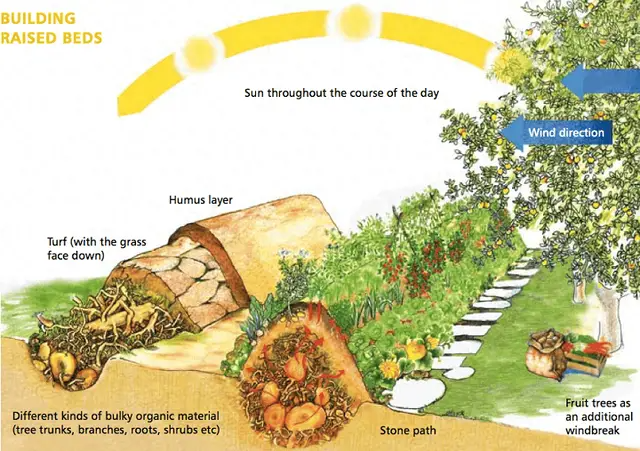

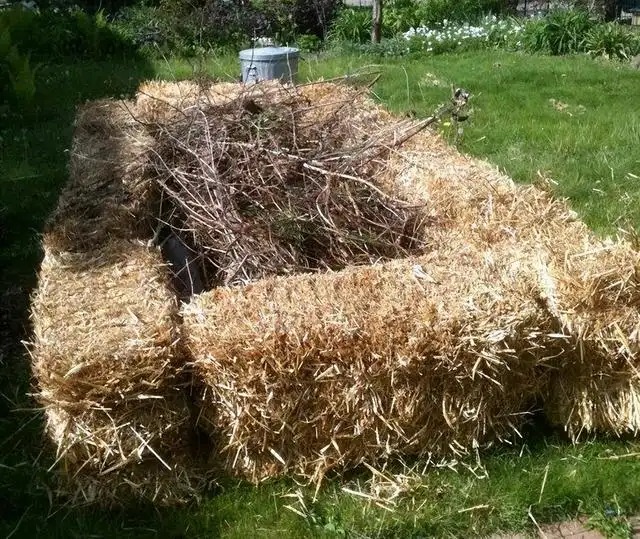
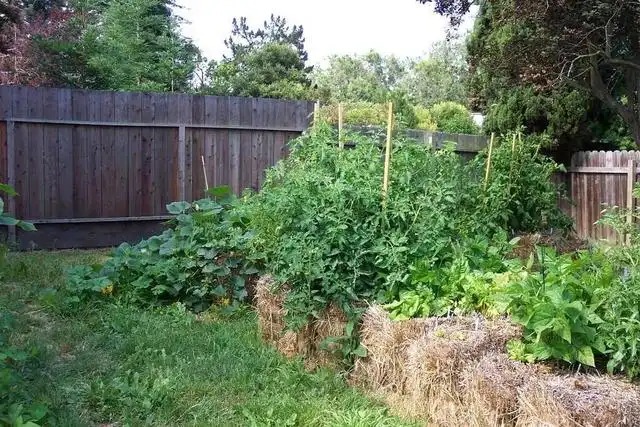
The process of constructing a hugelkultur bed can be either a simple exercise or a refined art form. First, you can create a small mound of decaying wood about 60 cm high on the ground. This will become the core of the hugelkultur bed.
Select the right pieces of wood and carefully arrange them like puzzle pieces, minimizing the gaps between them. This process requires patience and care, as you're creating a solid foundation for future plant growth. Once the wood is nearly aligned, you can fill the gaps with grass clippings and other finer, nitrogen-rich organic matter. This will help accelerate the decomposition of the humus, providing abundant nutrients for the plants.
Next, you'll need to cover the entire pile with a layer of fertile topsoil, about 5 cm thick. This layer of soil will serve as a growing medium for the plants, providing them with the necessary moisture and nutrients. Once the soil is laid, you can plant your favorite plants on and around it.
If you only have smaller wood materials to work with, creating a miniature hugelkultur bed is a good option. You can cover a pile of small and large branches with grass clippings and a layer of soil, then add a little urine to provide nitrogen. This will stimulate the decomposition of the wood and the growth of plants. After a season of careful care, when you dig up the pile again, you'll find that the wood has turned into humus.
The size of a hugelkultur bed depends entirely on your needs. Some prefer a compact, compact design, while others prefer a tall, spacious design. In fact, hugelkultur beds reaching nearly 2 meters in height and width are not uncommon in the gardening world.
Whatever size you choose, the key is to create a hugelkultur bed that is unique and functional based on your circumstances and gardening goals.
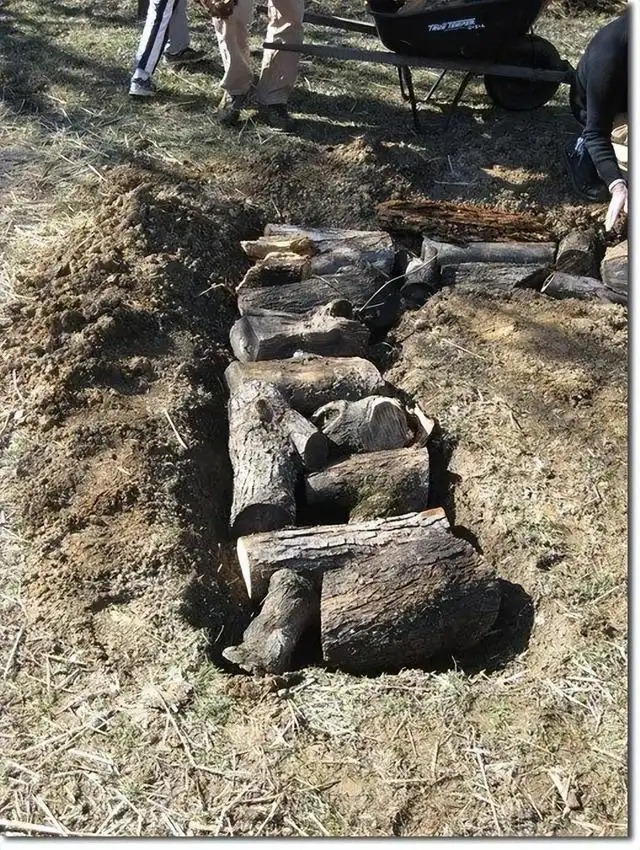

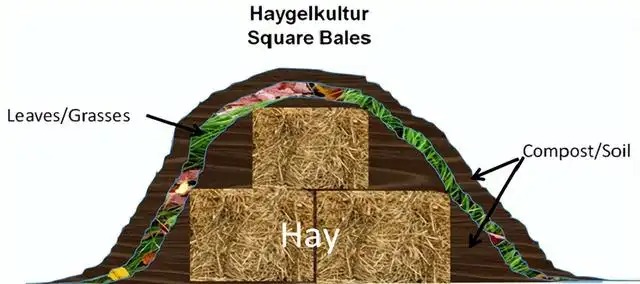
Rotting wood and grass clippings, seemingly insignificant in nature, spark a remarkable journey of decomposition when they meet. The rotting wood, rich in carbon, serves as the carbon source for this chemical reaction, while the grass clippings, rich in nitrogen, provide the essential nitrogen source. Their union foreshadows a vibrant transformation.
When you use fresh, carbon-rich wood, you may notice that the overall nitrogen content in the pile appears to decrease in the short term. This is because the fresh wood initially acts like a voracious predator, stealing nitrogen from surrounding materials to meet its own decomposition needs. However, this phenomenon is not irreversible.
The situation is different if you choose to use already decayed logs, wood that has already absorbed most or all of its total nitrogen holding capacity. When you build your hugelkultur, adding strong nitrogen sources like grass clippings and manure effectively offsets the nitrogen plunder of fresh wood. This extra nitrogen is like injecting new life into the compost bed, making it more balanced and vibrant.
Regularly adding urine to the Hugelkultur bed is also a very effective way to meet the wood's ongoing nitrogen needs. Once the fresh wood has absorbed its maximum nitrogen, it begins to decompose faster, gradually releasing nitrogen back into the surrounding soil and plants.
If you use wood chips or lots of smaller branches, you have more surface area for nitrogen absorption. This means you'll need to add more "greenery" to satisfy the nitrogen cravings of those tiny wood particles. By carefully adjusting the carbon and nitrogen ratio, you can create a healthy, active hugelkultur bed that provides a constant supply of nutrients for your plants.
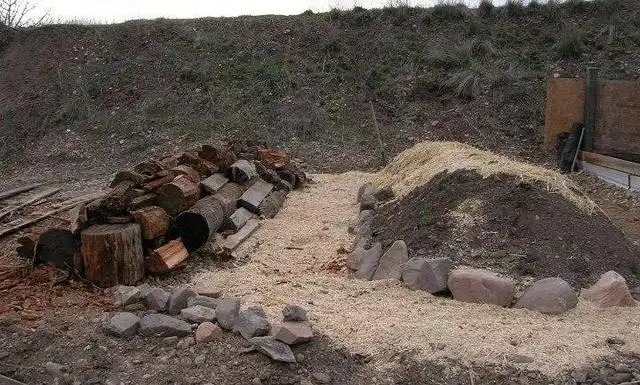

As the wood decomposes in the Hugelkultur bed, a magical phenomenon begins to occur. Tiny air pockets gradually form within the wood's fiber structure. These air pockets act like tiny channels, providing opportunities for bacteria and hyphae to enter the wood's interior.
Once these tiny organisms invade the air pockets, they begin their work. They feed on the wood, secreting enzymes and other chemicals that gradually break down the tough wood fibers into smaller fragments. During this process, bacteria and hyphae multiply, forming a vast microbial community that further accelerates the wood's decomposition.
Over time, these air pockets gradually expand and connect with each other, forming a complex network. However, this process isn't endless. When the wood has decomposed sufficiently, the air pocket structure becomes unstable and eventually collapses. This causes the Hugelkultur bed to gradually decrease in volume over the first year or two—a normal phenomenon of settling.
To counteract this settling, there are several measures you can take. Adding a new layer of chopped green manure or compost to the surface of the hugelkultur bed each year is an effective method. This not only replenishes nutrients in the soil but also provides a new food source for the microorganisms, keeping them active. Alternatively, you can initially make the seedbed slightly larger than you anticipate after settling to allow for this.
Through such careful management and maintenance, Hugelkultur beds maintain their fertility and productivity over time. They provide a favorable environment for plant growth and a home for microorganisms to thrive. This natural cycle and balance makes Hugelkultur beds a sustainable and eco-friendly agricultural practice.

Hugelkultur beds are an ingenious agricultural practice in arid environments, as they can be completely buried underground, providing plants with a steady supply of water and abundant nutrients.
The logs, some strong and sturdy, others slender and soft, are neatly arranged in the trenches, mixed with grass clippings and other organic matter, which not only provide the necessary conditions for the logs to decompose but also become valuable nutrients for future plant growth.
Once everything is ready, topsoil is gently applied over the logs and organic matter, completely burying them in the ground. This way, the wood material begins its decomposition journey deep within the soil, while plant roots gradually penetrate this fertile ground as they grow.
Buried Hugelkultur beds retain even more water than raised beds. In arid environments, they provide a reliable water source for plants. As roots grow into the decaying core of Hugelkultur soil, they draw on a constant supply of water and nutrients, enabling plants to thrive in harsh environments.
This deep-buried cultivation method not only makes full use of natural resources but also reduces water evaporation and loss. In this vibrant land, Hugelkultur cultivation beds have become a smart agricultural choice, providing solid support for plant growth.
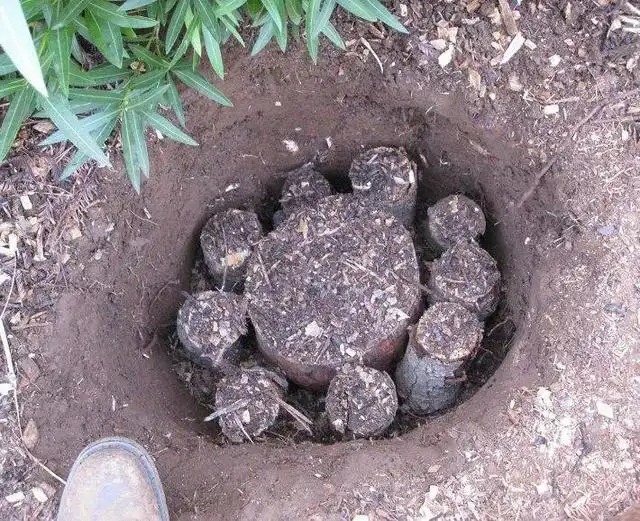
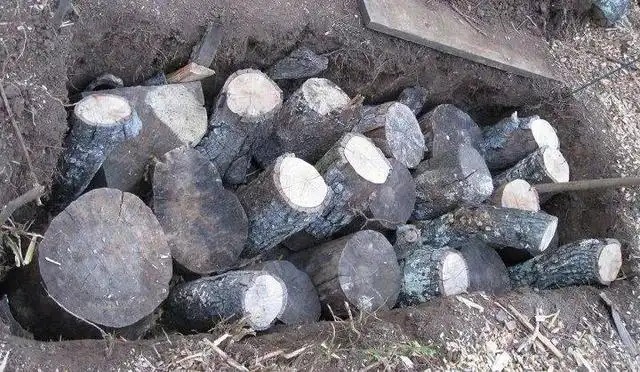
Imagine a pile of wood lying there quietly, seemingly motionless, yet actually containing enormous energy. A single spark could ignite it into a bonfire, releasing a warm glow and intense heat. This release of energy is so rapid and concentrated that it's impossible to ignore.
However, unlike burning in a campfire, the decomposition of wood in a Hugelkultur bed takes months or even years – a slow and persistent process that happens silently but also packs a huge amount of energy.
As the Hugelkultur bed decomposes, this energy is gradually released, generating heat. This heat not only helps stimulate plant root growth, allowing them to penetrate deeper into the soil, but also extends the plant's growing season. This means the plant has more time and opportunity to absorb nutrients and photosynthesize, resulting in more lush and robust growth.
Furthermore, this energy provides a constant source of fuel for a variety of organisms in the soil. Mushrooms, earthworms, termites, beetles... these organisms each play their own role in the Hugelkultur ecosystem, each interdependent. They utilize the energy and nutrients released during decomposition to thrive and reproduce, collectively maintaining the balance and stability of this ecosystem.
Of course, sometimes certain organisms, such as termites, may overpopulate. When their numbers reach unsustainable levels, there's no need to panic. Simply adding chickens to your Hugelkultur beds will effectively help. They will eat termites and other insects, effectively controlling their numbers and maintaining a balanced ecosystem. Their manure also provides additional nutrients to the soil, promoting plant growth. In this way, Hugelkultur beds create a virtuous cycle that allows us to use natural resources more efficiently.

To realize the full potential of a Hugelkultur bed, the initial construction height is crucial. Imagine a towering bed reaching a staggering 2.1 meters. This design isn't random; it's the product of careful consideration. This height ensures adequate nutrient supply and excellent water retention during the Hugelkultur's initial development.
However, the bed will change over time. Over the first few months to a year, the height of the bed will decrease as the wood decomposes and the soil settles. This is a natural process and is not something to worry about. Eventually, the bed will stabilize at 1.8 meters or less.
It's worth noting that the raised bed design not only improves the performance of the growing bed but also offers an often-overlooked benefit: increased planting area. Compared to traditional flat planting methods, raised beds allow us to grow more plants on the same land area. This not only improves land utilization but also provides gardening enthusiasts with more planting options and possibilities.
Therefore, consider height as an important factor when creating your Hugelkultur raised bed. With careful design and maintenance, you can create a gardening space that is both productive and aesthetically pleasing.
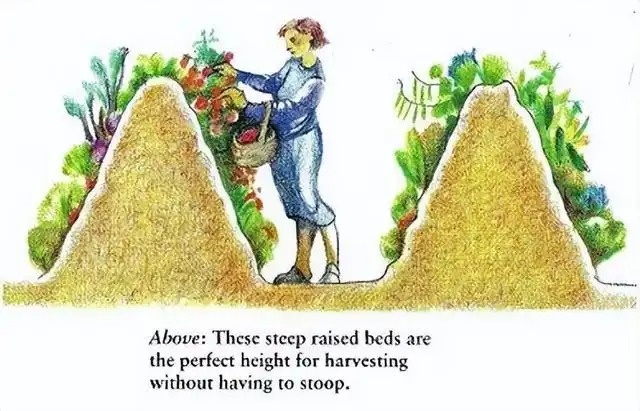
A significant advantage of using Hugelkultur raised beds is their exceptional moisture retention, far superior to humus alone. Imagine rotting logs lying quietly in a dense forest. Carefully peel back the surface layer, and a moist, vibrant world unfolds before your eyes. This moist environment remains relatively stable, regardless of external environmental fluctuations, except in the most extreme droughts.
The wood we bury underground acts like a giant sponge, silently performing its functions. Whenever rain falls, nutrients from the topsoil are washed deep underground. However, in the Hugelkultur growing bed, these precious water and nutrients are firmly trapped by the decaying wood. When drought strikes, plant roots can easily draw the water they need from the decaying wood.
Specifically, a 60-centimeter-high Hugelkultur bed, when saturated, can maintain usable moisture for approximately three weeks. A large bed up to 1.8 meters high is sufficient to provide plants with a constant supply of moisture throughout the growing season. In areas with moderate rainfall, this excellent moisture retention often allows some riparian species to thrive in areas where they would otherwise be unable to grow.
Over time, the wood in the growing bed gradually decays and eventually turns into humus. While humus may not retain water as well as decaying wood, it is much better at locking in other useful nutrients and oxygen. This transformation is a natural cycle that ensures the needs of plants at different stages of growth are met while continuously improving and optimizing the soil environment.

A farmer from Australia enthusiastically shared his insights on hugelkultur, praising it as an excellent way to dispose of unwanted woody organic matter. He described how he easily pushes the brush into a pile and then cleverly buries it beneath shredded grass and excess, low-quality soil. Not only does this method solve the headache of dealing with all the "waste" but it also offers unexpected benefits.
The farmer was delighted to discover that a side effect of this activity was the creation of fertile soil. He planted potatoes on this improved land and enjoyed a remarkable harvest in his first year. He excitedly described the thriving growth of the potato plants and the eventual harvest. This was all thanks to hugelkultur, a method that transforms organic matter, once considered useless, into valuable soil nutrients, providing ample nourishment and support for his crops.
This farmer's experience not only demonstrates the effectiveness of hugelkultur in processing organic waste, but also its great potential in improving soil quality and increasing crop yields. His story inspires more people to try this sustainable agricultural practice, turning waste into a resource, contributing to the prosperity of the land and the sustainable development of the ecosystem.
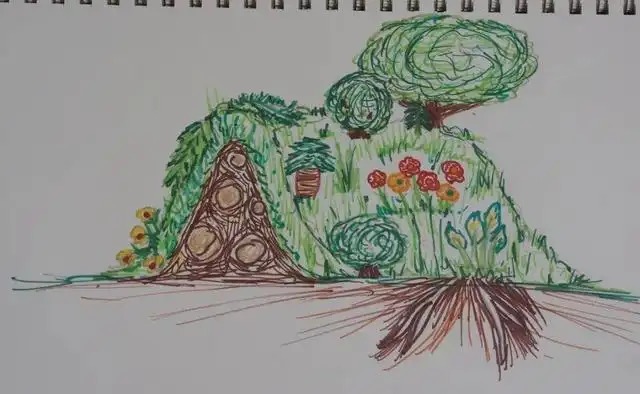
What's unique about hugelkultur beds is that their contents are primarily composed of decaying wood. This environment allows saprophytic fungi to dominate the biota, far outnumbering bacteria. Saprophytic fungi, which feed on dead matter, dominate this particular ecosystem. Bacteria, by contrast, prefer to live in an environment more similar to the humus we're ultimately creating.
This unique ecological composition presents interesting opportunities for those interested in designing hugelkultur beds. When initially constructing a hugelkultur bed, they can choose the desired fungal species to inoculate the wood with, thereby further manipulating and optimizing the ecosystem.
To ensure successful inoculation, an effective method is to cover the ground with several layers of cardboard before constructing the hugelkultur bed. This cardboard acts as a temporary barrier to other fungi, providing a relatively closed and favorable growth environment for the inoculated fungi. Once inoculated, the cardboard becomes a food source for the fungi, promoting their growth and reproduction.
The initial ratio of fungi to bacteria has a significant impact on tree growth. When fungi are abundant, they interact more closely with tree roots. Through a symbiotic relationship with tree roots, fungi exchange starch for nutrients, providing essential nutritional support. Furthermore, the fungal mycelium helps dissipate moisture stored in decaying wood to the surrounding area, further promoting tree growth and development.
Therefore, when designing and building hugelkultur beds, fully considering and utilizing the ecological characteristics of fungi and bacteria can create a more favorable environment for tree growth. This not only helps to increase the survival rate and growth rate of trees, but also further promotes the balance and stability of the ecosystem.
During the early stages of a hugelkultur bed, the first three to five years, the soil undergoes dramatic changes, providing invaluable opportunities for gardeners.
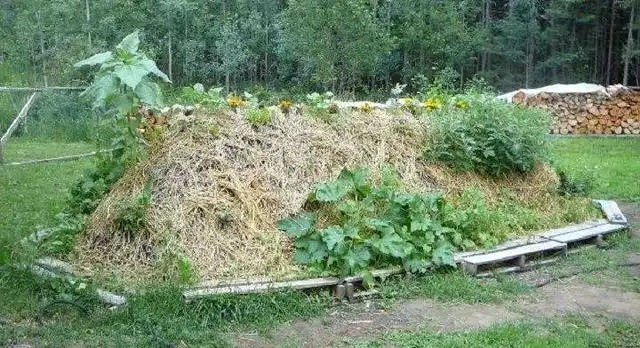
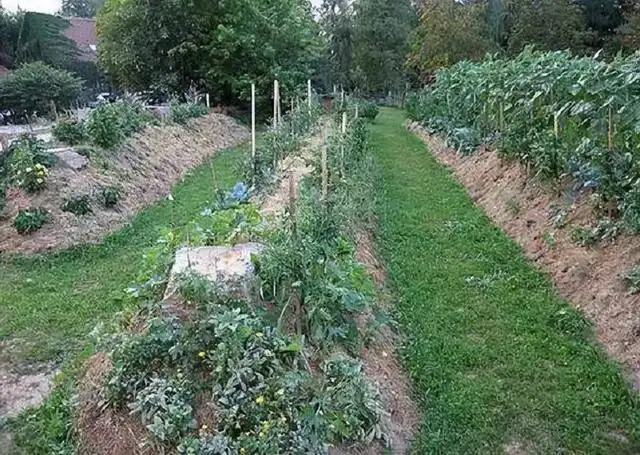
Initially, the soil is filled with dense, coarse woody material. This woody material not only adds a unique texture to the soil but also provides an ideal environment for pumpkins, melons, or other vines to grow. These plants spread along the woody material, showing their vitality.
At the same time, trees planted in or around hugelkultur beds also benefit significantly. The additional fungi in the soil interact with the tree roots, providing them with a rich supply of nutrients and the conditions they need to thrive. As Masanobu Fukuoka points out, planting trees in soil rich in robust organic matter, such as that found in hugelkultur beds, can significantly improve their performance.
Over time, humus accumulates in the soil, forming layer after layer of deep, fertile soil. Wood-decomposing fungi play a key role in this process, breaking down the woody material and converting it into nutrient-rich humus. Ultimately, a fertile mound rises, a source of pride for gardeners.
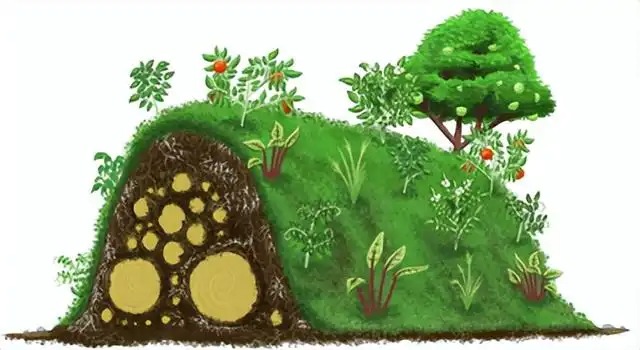
As trees thrive, the wood-decomposing fungi gradually disappear, making way for bacterial communities better suited to the growth of smaller plants. These bacteria breathe new life into the soil, making it even more suitable for a variety of plants to thrive. In this process, hugelkultur beds not only provide an ideal growing environment for larger plants like trees, but also create a vibrant home for smaller plants.
In addition to actively advocating for the burial of coarse organic matter to enrich soil texture, Fukuoka also explored how to gradually improve soil through the synergistic effects of a variety of plants. He particularly emphasized the importance of planting deep-rooted trees, grasses, and herbs. These plants not only have their own unique characteristics but can also contribute to soil improvement at different levels.
Deep-rooted trees, with their powerful root systems, penetrate deep into the soil, loosening and improving its structure while drawing nutrients from deeper layers, providing more growth opportunities for surface plants. Herbs and grasses, with their dense root systems, form a protective network on the surface, effectively preventing soil erosion and helping to secure and circulate nutrients in the soil.
Fukuoka further noted that "guiding and collecting nutrient-rich water from the highland forests above the land" is a key component of achieving sustainable, fertilizer-free agriculture. As natural water conservation areas, highland forests not only effectively purify water but also enrich the water flow with nutrients through natural processes such as leaf and branch litter. This nutrient-rich water is then channeled to farmland, providing essential irrigation for crops and replenishing valuable nutrients to the soil.
Through these comprehensive measures, Fukuoka's agricultural philosophy presents a three-dimensional, diverse ecological cycle system aimed at achieving continuous soil improvement and long-term sustainable agricultural development.
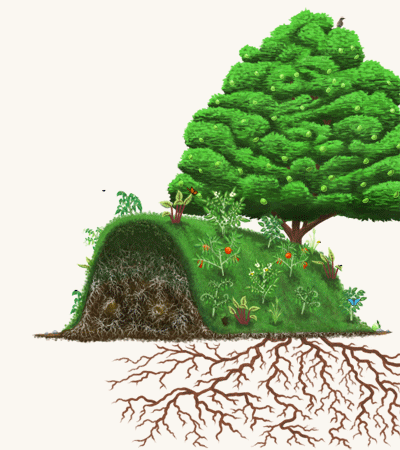
Suitable wood for hugelkultur beds:
- Alder
- Applewood
- birch
- Populus euphratica
- poplar
- willow
Unsuitable wood:
- Cedar (antimicrobial properties)
- Black walnut (contains toxins)
- Robinia pseudoacacia (rot-resistant)
- Pine/Pine Bark (Contains Tannins)
